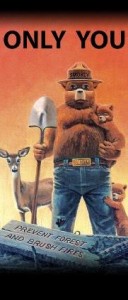70 Years Later Smokey Bear’s Still Significant
 When the typical American thinks of wildfire prevention, the first image that comes to mind is surely that of the iconic Smokey Bear.
When the typical American thinks of wildfire prevention, the first image that comes to mind is surely that of the iconic Smokey Bear.
Since the days of Smokey’s first words in 1944 – “Smokey says – care will prevent nine out of 10 forest fires.” – his likeness and slogans have been invaluable to federal, state and local agencies responsible for wildfire prevention and management.
For the Michigan Department of Natural Resources, Smokey was not only instrumental in establishing the importance of fire prevention education throughout the state, but also became one of the pillars upon which the DNR’s highly regarded fire program was built.
In recognition, the DNR will join the rest of the nation Saturday, Aug. 9, in celebrating Smokey Bear’s 70th birthday and all that this character has done to bring fire prevention to the forefront inMichigan.
The DNR’s fire program first began using Smokey Bear as a de facto spokesman for the cause in the 1960s, and today credits widespread public awareness about wildfire prevention to Smokey’s broad appeal.
Through the years, Smokey has appeared at countless community events and educational programs on behalf of the DNR, and the bear’s image and famous sayings have graced many DNR fire prevention promotional and educational materials.
“Every DNR Forest Resources Division (FRD) field office uses Smokey Bear at parades, fairs, school programs – anywhere we are trying to spread the fire prevention message,” said Paul Kollmeyer, manager of FRD’s Resources Protection and Cooperatives Programs section.
“Smokey is the catalyst that gets people’s interest, especially the young people,” Kollmeyer said. “When you’re delivering an educational program to second graders, you couldn’t ask for a more engaging teacher than Smokey. He really leaves an impression.”
Created by an art critic as part of an advertising campaign to educate the public about each individual’s role in preventing wildfires, Smokey made his official debut on a poster on Aug. 9, 1944. Wearing a pair of dungarees and a ranger hat, he is depicted pouring a bucket of water on a campfire.
Three years later, his slogan was modified to the long-lasting and well-known version, “Remember, Only YOU Can Prevent Forest Fires,” which stuck for another five decades before it was slightly updated to today’s version: “Only You Can Prevent Wildfires.”
Although Smokey was originally a fictional product of the World War II-era campaign, geared at shifting the public’s focus to fire prevention rather than suppression (since many citizens who would normally help fight fires were deployed overseas), his real-life counterpart was found six years later, clinging to a tree at the scene of a wildfire in New Mexico.
The bear cub had suffered burns to his paws and hind legs and was flown to the National Zoo in Washington, D.C., where he lived for 26 years, becoming an integral part of the Smokey campaign.
In 1952, Smokey became the subject of a song, “Smokey the Bear,” and that same year, his image was legally protected under the federal Smokey Bear Act, which established three administrators of the image: the U.S. Forest Service, National Association of State Foresters, and Ad Council.
Now 70 years old, the Smokey Bear wildfire prevention campaign is a bit of an anomaly in how popular it remains, still striking a chord with audiences of all ages after seven decades of heavy rotation.
According to the national non-profit Ad Council, Smokey and his message are recognized today by 95 percent of adults and 77 percent of children.
“What’s so unique about Smokey is the multi-generational appeal. People and kids of all ages can relate to each other over Smokey Bear,” said Gwinn Unit fire supervisor Pete Glover. “One of my favorite parts about our Smokey Bear appearances is seeing a grandparent who is just as excited about having their picture taken with Smokey as their grandchild is.”
With the busy and complicated lives parents lead today, Glover said he recognizes that Smokey’s presence is vital to the positive reception of the many educational programs fire officers give each year.
“It would be difficult to get parents to come to an evening or weekend program if their kids weren’t interested in attending as well,” he said. “Smokey holds the attention of the younger audience members, giving us time to really drive the wildfire prevention message home to the parents and other adults in the audience.”
With the help of DNR fire officers and volunteers around the state, Smokey Bear makes more than 100 public appearances annually, including National Night Out public safety events, where he is typically swarmed with visitors hoping to get a hug, high-five and photo with Smokey.
And when they leave an event, Smokey’s fans don’t only have smiles on their faces – they also leave with their hands full of educational “Smokey swag” promoting the fire prevention message.
“Smokey is the linchpin that made fire prevention popular nationwide and inMichigan,” Kollmeyer said. “Without our use of his image, slogans, voice and presence, I am not sure we would have such an educated public when it comes to wildfire awareness and prevention.”
“I hope in 70 years, fire programs around the country will be celebrating Smokey Bear’s 140th birthday.”
